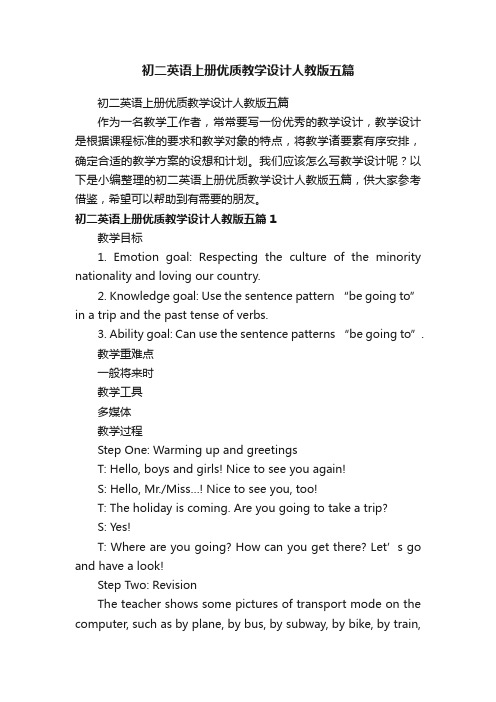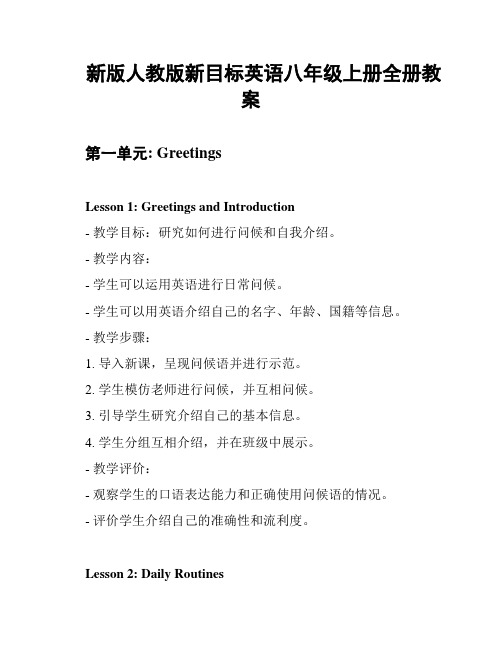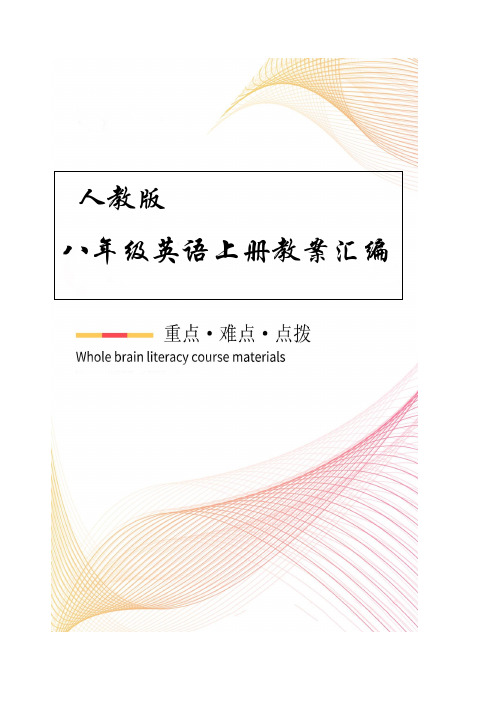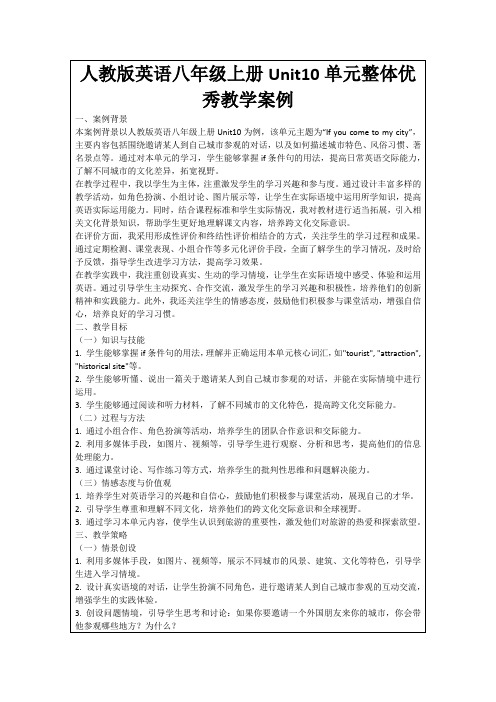初中英语人教版八年级上册英语教案
【教案】新版人教版八年级上册英语教案

【教案】新版人教版八年级上册英语教案第一课时教学目标1. 研究询问别人的姓名和年龄的表达方式并能够流利运用。
2. 掌握数字 one 到 twenty 的发音和英语书写形式。
3. 培养学生的口语表达能力和自信心。
教学重点1. 询问别人的姓名和年龄的表达方式。
2. 数字 one 到 twenty 的发音和英语书写形式。
教学难点1. 如何帮助学生提高口语表达能力。
教学过程1. Warming-up利用图片或教具,引入数字 one 到 twenty。
2. Presentation根据教材第一页的内容,介绍如何询问对方姓名和年龄,帮助学生了解常见的礼貌用语,例如 excuse me,What's your name? 和How old are you? 等。
3. Practice3.1 学生两人一组进行练,模拟真实场景,询问对方姓名和年龄,并记录下来。
3.2 学生分组进行数字 one 到 twenty 的听说练,教师检查每组的发音和读音。
4. Production4.1 学生分组进行对话,可以创造自己的场景并使用所学的语言进行对话练。
4.2 教师抽取三名同学进行 oral presentation,检查学生口语表达能力。
作业完成教材第二页的练。
教学反思本节课教学重点是询问别人的姓名和年龄的表达方式并能够流利运用,以及数字 one 到 twenty 的发音和英语书写形式。
通过多种形式的练习,帮助学生提高口语表达能力。
教学效果良好,但在课堂上发现学生们的英语基础参差不齐,因此需要针对不同学生制定个性化的教学计划。
人教版英语八年级上册Unit2Howoftendoyouexercise大单元优秀教学案例

2.问题导向的探究式学习
本案例以问题导向为核心,引导学生主动探究、思考。通过设计一系列具有挑战性和趣味性的问题,激发学生的好奇心,培养他们的思维能力。在这种探究式学习过程中,学生不仅掌握了英语知识,还学会了如何用英语进行思考和表达,提高了他们的英语素养。
(二)问题导向
问题导向是本章节教学的重要策略。我将围绕单元主题,设计一系列有趣且具有挑战性的问题,引导学生进行思考、讨论和探究。例如:“How often do you exercise? Why is it importantto exercise regularly? What are the benefits of exercising?”等问题,激发学生的好奇心,培养他们主动探究问题的能力。
(三)学生小组讨论
在学生小组讨论环节,我会将学生分成若干小组,每组根据教师提供的问题或任务进行讨论。例如,我可能会给出以下问题:“What sports do you like to play? How often do you exercise? Can you talk about the benefits of exercising?”等。学生可以结合自己的实际经历和观察,用英语进行讨论。在此过程中,我会在各组之间巡回指导,关注学生的语言运用,并及时提供帮助。
在评价过程中,关注学生的全面发展,不仅关注他们的英语知识掌握程度,还要关注其情感态度、合作精神、创新意识等方面。通过鼓励性、指导性的评价,帮助学生建立自信,激发他们进一步学习英语的积极性。
初二英语上册优质教学设计人教版五篇

初二英语上册优质教学设计人教版五篇初二英语上册优质教学设计人教版五篇作为一名教学工作者,常常要写一份优秀的教学设计,教学设计是根据课程标准的要求和教学对象的特点,将教学诸要素有序安排,确定合适的教学方案的设想和计划。
我们应该怎么写教学设计呢?以下是小编整理的初二英语上册优质教学设计人教版五篇,供大家参考借鉴,希望可以帮助到有需要的朋友。
初二英语上册优质教学设计人教版五篇1教学目标1. Emotion goal: Respecting the culture of the minority nationality and loving our country.2. Knowledge goal: Use the sentence pattern “be going to” in a trip and the past tense of verbs.3. Ability goal: Can use the sentence patterns “be going to”.教学重难点一般将来时教学工具多媒体教学过程Step One: Warming up and greetingsT: Hello, boys and girls! Nice to see you again!S: Hello, Mr./Miss…! Nice to see you, too!T: The holiday is coming. Are you going to take a trip?S: Yes!T: Where are you going? How can you get there? Let’s go and have a look!Step Two: RevisionThe teacher shows some pictures of transport mode on the computer, such as by plane, by bus, by subway, by bike, by train,on foot. Then practice them in sentences.Step Three: Let’s readThe teacher shows some important sentences in dialogue on the computer:A:Where are you going on your holiday?B:I am going to….A: Who are you going with?B:I am going with….A:What are you going to do there?B:I am going to….A: When are you going?B:At…Step Four: ListenListen to the tape, read after the tape and find out the new words: Kunming, Kathy, folk (folk dance), Stone Forest.Step Five: Presentationa. Fill these new words in blanks on the computer, read the new words again.b. .Analyze the difficulty: How is your family going to get there?c. Listen and read the dialogue.Step Six: PracticeFill in Mike’s trip schedule.Step Seven: Consolidation and extensionPlan your holiday and make a dialogue.Step Eight: Homework.Pair work to make your own dialogue.V.Blackboard Design:Where to go? What to do?Kunming. See folk dances.When to go? How to get?初二英语上册优质教学设计人教版五篇2教学目标知识目标:1、能够听说读写句型:--How did you go there? I went by train .2. 能听懂、会说本课对话,并能在实际情景中应用。
新版人教版新目标英语八年级上册全册教案

新版人教版新目标英语八年级上册全册教案第一单元: GreetingsLesson 1: Greetings and Introduction- 教学目标:研究如何进行问候和自我介绍。
- 教学内容:- 学生可以运用英语进行日常问候。
- 学生可以用英语介绍自己的名字、年龄、国籍等信息。
- 教学步骤:1. 导入新课,呈现问候语并进行示范。
2. 学生模仿老师进行问候,并互相问候。
3. 引导学生研究介绍自己的基本信息。
4. 学生分组互相介绍,并在班级中展示。
- 教学评价:- 观察学生的口语表达能力和正确使用问候语的情况。
- 评价学生介绍自己的准确性和流利度。
Lesson 2: Daily Routines- 教学目标:研究描述日常活动。
- 教学内容:- 学生能够运用英语描述自己的日常活动。
- 学生可以用英语叙述一天的活动安排。
- 教学步骤:1. 复前一课的内容,引导学生回忆日常活动的英语表达。
2. 引导学生研究新的日常活动的词汇和句型。
3. 学生分组分享自己的一天活动安排,并向全班汇报。
- 教学评价:- 观察学生对日常活动词汇和句型的掌握程度。
- 评价学生的口语表达和沟通能力。
第二单元: Hobbies and Leisure ActivitiesLesson 1: Hobbies- 教学目标:研究谈论自己的兴趣爱好。
- 教学内容:- 学生可以用英语描述自己的兴趣爱好。
- 学生可以运用所学词汇进行对话练。
- 教学步骤:1. 复前一课的词汇和句型。
2. 引导学生研究新的兴趣爱好词汇。
3. 学生分组进行对话练,谈论自己的兴趣爱好。
- 教学评价:- 观察学生对兴趣爱好词汇的掌握情况。
- 评价学生在对话练中的口语表达能力。
Lesson 2: Leisure Activities- 教学目标:研究谈论闲暇活动。
- 教学内容:- 学生能够用英语描述自己的闲暇活动。
- 学生能够与他人交流关于闲暇活动的话题。
- 教学步骤:1. 复前一课的词汇和句型。
人教版八年级英语上册全册教案(超详细)

人教版八年级英语上册教案汇编Unit 1Where did you go on vacation?本单元教材以Where did you go on vacation?为中心话题,围绕着描述“过去发生的事情”展开,学习和运用一般过去时态的一般疑问句Did you go/see/buy...?和特殊疑问句Where/What/How...?询问过去的事件,让学生学会谈论和分享过去发生的事件。
本课教学内容与学生的实际生活密切相关,易于引发学生运用简单的英语进行交流。
在学习活动中,学生通过交换对过去发生的事情的描述及看法,促进学生之间和师生之间的情感交流,增进情谊。
Section A的主要学习内容是:复习一般过去时态和动词的规则与不规则变化,学习一般过去时态的一般疑问句:Did you...?及不定代词的用法。
Section B安排了许多听、说、读、写的任务活动,教师在教学中可以灵活运用这些活动,将其中的一些活动进行变化或整合,充分调动学生参与的积极性,提高学生的听说读写能力。
第一课时Section A(1a-2d)Teaching Goals【教学目标】Key words & phrases:anyone,anywhere,wonderful,few,most,quite a few,go on vacationKey sentences:1.Where did you go on vacation?I went to the mountains/New York City/summer camp/the beach.2.Did you...?Yes,I did./No,I didn't.Teaching Key Points【教学重点】The vocabulary:New York City,Central Park,few,most,quite a few,on vacationTarget language:Where did you/they/he/she go on vacation?I/They/He/She went to the mountains/New York City/summer camp/the beach. Did you...?Yes,I did./No,I didn't.Teaching Difficult Points【教学难点】Use the target language above to talk about past events.Teaching Aids【教学工具】An English textbook,a tape recorder,CAI or courseware.Teaching Steps【教学过程】★Step 1Leading inGreet the class and introduce what to learn in this period.Teacher:Welcome back to school!Did everyone have a good time during the summer vacation?Today we'll begin to learn the topic where you went on vacation.Teacher:Where did you go on vacation?Students:______.①I went to the mountains.②I visited museums.…★Step 2Pre-taskPage 1,1a & 1b.1.Look at the picture.2.Match each activity.3.Check the answers in 1b.4.Practice reading.Page 1,1c.1.Focus on the conversation in the box.2.Practice reading.3.Pairwork:Where did you go on vacation?I...4.Groupwork:Divide the class into groups of four or five. Make conversations.First S1 to S2:S1:Where did you go on vacation?S2:I...S1:Where did she/he go on vacation?S2:She/He...★Step 3While-taskPage 2,2a & 2b.1.Play the recording for the first time. Students complete the chart in 2a.2.Check the answers.(Point to one student who raises his or her hand.)3.Play the recording a second time and say:There are three conversations. The people talk about where they went on vacation. Listen to the recording and check(√)Yes,I did or No,I didn't for each question.4.Correct the answers.★Step 4Post-taskPage 2,2c & 2d.1.Focus on the conversation in 2c & 2d.2.Practice reading. Make students scan the conversations first.3.Teach and then make students role-play the conversation in pairs.4.Have a group of students present their conversation to the class.★Step 5Homework1.Practice the conversation on Page 2,2d.2.Do the exercises on Page 1 in students' book.Board Design板书设计Unit 1Where did you go on vacation?The first period Section A(1a-2d)1.Key vocabulary:anyone,anywhere,wonderful,quite a few,go on vacation 2.Target language:A:Where did Tina go on vacation?B:She went to the mountains.第二课时Section A(GF-3c)Teaching Goals【教学目标】Key words:something,nothing,everyone,myself,yourself,someone,seem,bored,diaryKey phrases:go out,have a good time,of course,keep a diaryKey sentences:1.Where did you go on vacation?I went to New York City.2.Did you go out with anyone?Did you buy anything special?3.How was the food?How was your vacation?Teaching Key Points【教学重点】The vocabulary:something,nothing,everyone,myself,yourself,someone,seem,bored,diary,go out,have a good time,of course,keep a diary,on vacation Target language:How was the food?Everything tasted really good!Did you go shopping?Of course!Did everyone have a good time?Oh,yes. Everything was excellent.Teaching Difficult Points【教学难点】e the target language above to talk about past events.2.The usage of someone,anyone,everyone,no one,something,anything,everything,nothing.Teaching Aids【教学工具】An English textbook,CAI or courseware.Teaching Steps【教学过程】★Step 1Leading in(T—teacher S—student)T:Where did you go last weekend?S:I went to the beach.T:Did you go there with anyone?S:Yes. I went to the beach with my brother.T:Did you have a good time there?S:...★Step 2Pre-taskPage 3,Grammar Focus.1.Review the grammar box. Work in pairs. One asks and the other answers.2.Practice reading the sentences in the chart.★Step 3While-taskPage 3,3a & 3b.1.Teach these new words:anyone,something,anything,everything,nothing,everyone,no one.2.Call students' attention to the conversation in 3a. Make students complete it individually.3.Choose a student to give his or her answers. Write the answers on the board.4.Correct the answers.5.Lead students to read this conversation.6.Have students work in pairs and role-play the conversation. As they talk,move around the classroom monitoring their work. Offer language or pronunciation support as needed.7.Make students complete the blanks in the e-mail message in 3b with the words in the box.8.Check the answers and then make students practice reading it.★Step 4Post-taskPage 3,3c.Complete the task in 3c.Ask your group questions about their last vacation. Then tell the class your results.★Step 5Homework1.Review the indefinite pronouns learned in this period.2.Do the exercises on Page 2 in students' book.Board Design板书设计Unit 1Where did you go on vacation?The second period Section A(GF-3c)1.The vocabulary:something,nothing,everyone,someone,myself,yourself,go out,of course2.Target language:①A:Where did you go on vacation?B:I went to New York City.②A:Did you buy anything special?B:Yes,I bought something for my father.3.Structure:something special4.Answers to 3a and 3b.第三课时Section B(1a-1e)Teaching Goals【教学目标】Key words:delicious,exciting,terrible,expensive,cheap,boringKey sentences:1.Where did Lisa go on vacation?2.Did she do anything special there?Did she buy anything for her best friend?Did Lisa like her vacation?3.How was/were...?Teaching Key Points【教学重点】The vocabulary:delicious,exciting,terrible,expensive,cheap,boringTarget language:Where did Lisa go on vacation?Did she do anything special there?Did she buy anything for her best friend?How was/were...?Teaching Difficult Points【教学难点】1.询问去过何地以及感受(评价)Where did you go?I went to the beaches. How was it?It was exciting.2.Use the target language to talk about your past events.Teaching Aids【教学工具】An English textbook,a tape recorder,CAI or courseware.Teaching Steps【教学过程】★Step 1Leading in1.Greetings.2.T:Where did you go on vacation?S:I went to summer camp.T:Did you do anything special there?S:Yes,I...T:Did you buy anything for your parents or friends?S:Yes,I bought...for.../No,I bought nothing.T:How was/were...?S:It was/They were...★Step 2Pre-taskPage 4,1a & 1b.1.Look at the six pictures.2.Match the words with the pictures.3.Students complete the task in 1b individually.4.Check the answers.★Step 3While-taskPage 4,1c & 1d.1.Make students scan the questions in 1c.2.Play the recording for the first time. And say:Listen to the tape. Lisa is talking about her vacation. Complete the four questions.3.Play the recording a second time. Students complete the task in 1d.4.Correct the answers.★Step 4Post-taskPage 4,1e.Ask 3 or 4 students to answer questions about Lisa's vacation. You can begin your questions with:Where did...?What did...?Did she...?How was...?How were...?★Step 5Homework1.Review these sentences:Where did...?Did...?How was/were...?2.Do the exercises on Page 3 in students' book.Board Design板书设计Unit 1Where did you go on vacation?The third period Section B(1a-1e)1.Words:delicious,exciting,terrible,expensive,cheap,boring2.Sentences:①Where did Lisa go on vacation?②Did she buy anything special?③Did she buy anything for her best friend?④Did Lisa like her vacation?3.Answers to Activity 1a:1—5f a c e b dAnswers to Activity 1b:wordsdeliciousexcitingcheapwordsterribleexpensiveboring第四课时Section B(2a-2e)Teaching Goals【教学目标】Key words:activity,decide,try,bird,bicycle,building,trader,wonder,difference,top,wait,umbrella,wet,below,enough,hungry,asKey phrases:feel like,because of,go to the beach,a lot of,a little,take the train,too many,what aboutKey sentences:1.I wonder what life was like here in the past.2.What a difference a day makes!3.We waited over an hour for the train because there were too many people.Teaching Key Points【教学重点】Learn Jane's diary entries about her vacation.1.The vocabulary:activity,decide,try,wonder,difference,wait,below,enough,hungry,as,feel like,because of2.Target language:I wonder what life was like here in the past. We waited over an hour for the train because there were too many people.Teaching Difficult Points【教学难点】1.because and because of2.What a difference a day makes!3.Learn to write a diary.Teaching Aids【教学工具】An English textbook,CAI or courseware.Teaching Steps【教学过程】★Step 1Leading in1.Greetings.2.Introduce what to learn in this period,especially the articles in 2b,Jane's diary entries. Teacher begins like this:Today we'll focus on two diary entries about Jane's vacation. Through the learning you'll know how to write a diary. Let's begin now.★Step 2Pre-taskPage 5,2a & 2b.1.Review and discuss the questions in 2a box with your partner.2.Project these new words on the screen or write them on the board and teach the new words. Ask students to repeat them. And make sure everyone knows the meanings.activity n.活动;decide v.决定;try v. & n.尝试,设法;wonder v.想知道;difference n.差异;top n.顶部;wait v. & n.等待;umbrella n.伞;below prep.& adv.在……下面;enough adj.充足的;hungry adj.饥饿的3.Make students scan the articles first. Ask students to put a mark in contents that are unfamiliar to them. Then the teacher lead students to learn these two articles sentence by sentence. Pay attention to these points:(1)decide v.决定;decide to do sth.决定做某事;(2)try v.尝试;try doing sth.尝试做某事;try to do sth.尽力做某事;(3)below prep. & adv.在……下面;(4)feel like 给……的感觉;(5)because and because of;(6)wonder v.想知道4.Practice reading.★Step 3While-taskPage 6,2c & 2d.1.Make students read Jane's diary entries again. Fill in the chart in 2c.2.Students complete the conversation in 2d using the information in Jane's dairy entries.3.Choose 3 or 4 students to give their answers.4.Correct the answers.5.Have students work in pairs. Student A will be Anna and student B will be Jane. Act the conversation out.★Step 4Post-taskPage 6,2e.1.Make students complete the blanks in 2e.2.Ask one student to write his or her answers on the board.3.Check the answers together with the class.4.Practice reading.★Step 5Homework1.Write a diary.2.Do the exercises on Page 4 in students' book.Board Design板书设计Unit 1Where did you go on vacation?The fourth period Section B(2a—2e)1.Key vocabulary:decide,try,wonder,difference,top,wait,below,enough,hungry,as,feel like,because of,too many2.Sentences:①I wonder what life was like here in the past.②And because of the bad weather,we couldn't see anything below.第五课时Section B(3a-Self Check)Teaching Goals【教学目标】Key words & phrases:duck,dislike,take photos,Tian'anmen Square,the Palace Museum,bring back,shopping center,have a fun time,school trip,come upKey sentences:1.How did you feel about the trip?2.It was so beautiful that we forgot about the last five hours!Teaching Key Points【教学重点】The vocabulary:dislike,take photos,Tian'anmen Square,the Palace MuseumTarget language:What did you like best?Did you dislike anything?How did you feel about the trip?Teaching Difficult Points【教学难点】Write a travel diary.Teaching Aids【教学工具】An English textbook,CAI or courseware.Teaching Steps【教学过程】★Step 1Leading in1.Greetings.2.T:Beijing is the capital of our country. It's famous for its long history and places of interest,such as Tian'anmen Square,the Palace Museum,the Summer Palace and so on. And Beijing duck is very delicious. Have you ever been to Beijing?Tell your travel to us.★Step 2Pre-taskPage 7,3a.1.Look at the three pictures.2.Use the words and phrases in the box to complete the blanks in the article.3.Check the answers.★Step 3While-taskPage 8,Self Check.Complete the tasks in Self Check.1.Have students complete the task of Part 1.Then Choose 2 or 3 students to give their answers. Check the answers.2.Induct students to complete the passage of Part 2.Check the answers.3.Practice reading.★Step 4Post-taskPage 7,3b & 3c.1.Make students answer the questions in 3b and take notes.2.Teach students how to write a travel diary.3.Students write a travel diary like Jane's on Page 5 using the notes in 3b.4.Choose 2 or 3 students' diaries. Make students read them out. Point out the weakness and induct the students to correct their diaries.★Step 5Homework1.Write a travel diary.2.Do the exercises on Page 5 in students' book.Board Design板书设计Unit 1Where did you go on vacation?The fifth period Section B(3a-Self Check)1.Key vocabulary:dislike,Tian'anmen Square,the Palace Museum,have a fun time,come up2.Sentences:①Did you dislike anything?②How did you feel about the trip?③My legs were so tired that I wanted to stop.Unit 2How often do you exercise?本单元的教学内容围绕“多久做一次运动”这一话题展开。
八年级上册英语教案人教版5篇

八年级上册英语教案人教版5篇八年级上册英语教案人教版篇1一、教材内容分析本课是人教版八年级上册英语第一单元第三个话题的第一课时,主要谈话讨论如何给别人提出建议,并给予适当的评论。
二、教学目标(知识,技能,过程与方法情感态度、价值观)1、知识与技能(1)掌握Why don’t you get her a scarf ? That’s too boring .这种句型,并认识新单词。
(2)运用新句型熟练的进行小组对话。
(3)进行听力练习。
2、过程与方法(1)能够通过师生说、两两说和自主听读体验交际式英语教学的一般过程,掌握英语说听的基本方法;(2)能够通过两两说和综合说体验合作学习的过程和方法;(3)能够仔细倾听老师和同学的发言,有语言表达和与同学交流的愿望。
(4)能够通过观看图片激发说话的欲望。
3、情感态度与价值观(1)培养学习英语的兴趣;(2)在学生两两交流和小组合作交流中,培养孩子合作意识和合作精神,能够相互配合完成一段通顺流畅的说话训练;(3)使学生学会礼貌待人。
三、学习者特征分析1、学生是八年级的学生。
2、学生已经学习了camera、hat,flowers 等物品的词。
3、学生对 great,interesting,boring 这些评论性的词非常熟悉。
4、学生好奇心强,对送什么礼物很感兴趣。
5、学生善于表现自己,乐于交际。
6、学生的听力能力不够强。
四、教学策略选择与设计1、谈话策略:运用谈话法引入新课。
2、自主听读策略:学生通过自主听读拓展材料,在完成课标要求的基础上训练听说能力,积累和丰富英语词汇和句式。
3、角色扮演法:让学生通过扮演不同角色,小组对话练习熟练地掌握重点句型。
五、教学环境及资源准备1多媒体教室。
2 本课教材,课件。
六、教学过程教学过程教师活动学生活动设计意图及资源准备Step1: Greeting Hello , cliass! How are you! Are you happy ... Greeting. 拉近教师和学生的距离。
人教版英语八年级上册Unit10单元整体优秀教学案例

1.组织学生进行小组讨论,共同完成任务,如设计一份城市旅游攻略,培养学生团队合作意识和交际能力。
2.鼓励学生互相帮助、互相学习,培养他们的合作精神和团队意识。
3.通过小组合作,使学生学会倾听、理解和尊重他人的意见,培养他们的跨文化交际能力。
(四)反思与评价
1.引导学生对自己的学习过程进行反思,总结自己的学习成果和不足之处,提高自我认知和自我调整能力。
(四)总结归纳
1.让学生总结本节课所学的知识,包括if条件句的用法和核心词汇。
2.引导学生思考和讨论:邀请朋友来自己的城市参观的意义是什么?如何做好一个热情的导游?
3.总结本节课的学习内容,强调跨文化交际的重要性和实际运用能力。
(五)作业小结
1.布置作业:要求学生写一篇短文,邀请一个外国朋友来自己的城市参观,并描述城市的特色和景点。
2.强调作业的目的是巩固所学知识,提高写作能力和跨文化交际能力。
3.提醒学生按时完成作业,并鼓励他们积极思考和运用所学知识。
五、案例亮点
1.真实的教学情境:通过展示不同城市的风景图片和设计真实语境的对话,让学生感受到实际交际场景,提高了学生的学习兴趣和积极性。
2.学生主体性的发挥:在教学过程中,我注重引导学生主动探究、合作交流,鼓励他们提出问题、寻找答案,充分发挥了学生的主体性。
在评价方面,我采用形成性评价和终结性评价相结合的方式,关注学生的学习过程和成果。通过定期检测、课堂表现、小组合作等多元化评价手段,全面了解学生的学习情况,及时给予反馈,指导学生改进学习方法,提高学习效果。
在教学实践中,我注重创设真实、生动的学习情境,让学生在实际语境中感受、体验和运用英语。通过引导学生主动探究、合作交流,激发学生的学习兴趣和积极性,培养他们的创新精神和实践能力。此外,我还关注学生的情感态度,鼓励他们积极参与课堂活动,增强自信心,培养良好的学习习惯。
人教版英语八年级上册Unit7课时优秀教学案例

4.多元化的教学评价:注重过程性评价与终结性评价相结合,既关注学生在课堂上的表现,又关注他们在课后实践中的应用。通过这种方式,全面、客观地评价学生的学习成果,并为他们提供及时的反馈,以促进他们的进一步发展。
5.注重学生综合素质的培养:在教学过程中,不仅关注学生的语言表达能力,还关注他们的团队协作能力、创新思维和生活实践能力的培养。通过设计各种互动环节和实践活动,激发学生的学习兴趣,培养他们的综合素质。
2.学生通过小组合作,培养团队协作能力和创新思维。
3.学生通过角色扮演、小组讨论等互动环节,提高口语表达能力,增强自信心。
4.学生通过自主学习、合作学习、探究学习等方法,提高学习兴趣,培养自主学习能力。
(三)情感态度与价值观
1.学生能够认识到学习英语的重要性,激发学习英语的兴趣,增强自信心。
2.学生通过与同伴合作,培养合作精神,学会尊重他人,善于倾听。
2.紧接着,我向学生介绍本节课的主题:“How do you make salad?”,并提问:“你们知道什么是沙拉吗?你们有没有自己制作过沙拉?”通过这个问题,引发学生的思考和兴趣,为接下来的教学内容做铺垫。
3.展示一幅美丽的沙拉图片,引导学生观察并描述图片中的沙拉。通过这个活动,培养学生的观察力和口语表达能力。
人教版英语八年级上册Unit7课时优秀教学案例
一、案例背景
本案例背景以人教版英语八年级上册Unit7为例,该单元主题为“How do you make salad?”,主要内容涉及制作沙拉的方法、食材的选择以及询问他人制作某道菜的方式。本节课旨在帮助学生掌握相关词汇和句型,提高他们的口语表达能力,并培养他们的创新思维和团队协作能力。
- 1、下载文档前请自行甄别文档内容的完整性,平台不提供额外的编辑、内容补充、找答案等附加服务。
- 2、"仅部分预览"的文档,不可在线预览部分如存在完整性等问题,可反馈申请退款(可完整预览的文档不适用该条件!)。
- 3、如文档侵犯您的权益,请联系客服反馈,我们会尽快为您处理(人工客服工作时间:9:00-18:30)。
一、教学目标:
1. 语言知识目标:
1) 复习所学的重难点句型及句式结构。
2)总结学习anyone, someone, everyone, something, anything, nothing等不定代词的用法。
3)练习运用所学的句型及句式结构。
2. 情感态度价值观目标:
学会用一般过去时进行信息交流,培养学生的环保意识,热爱大自然。
二、教学重难点
1. 教学重点:
1) 用所学的功能语言交流假期去了什么旅行。
2) 复习运用本课时出现的新词汇。
2. 教学难点:
1) 复合不定代词someone, anyone, something, anything等的用法。
2) 阅读填空能力的提高。
三、教学过程
Ⅰ. Warming- up and revision
1. Free talk: Ask Ss the questions: Where did you go on vacation?
Ss try to answer the questions.
2. Review the usage of “复合不定代词”
Ⅱ. Grammar focus.
1. 学生阅读Grammar Focus中的句子,然后做填空练习。
1. 你去了什么地方去度假?
______ ______ you go on ___________?
2. 我去了纽约市。
I _______ _______ New York City.
3. 你和什么人别一起去的吗?
______ ______ go out with ________?
4. 不,没有别人在这儿。
每个人都在度假。
No. ____ ______ was here.
________ was on _________.
… (其余试题见课件部分)
3. 学生们完成填空试题后,可以打开课本检查答案,对错误的句子,单独进行强化记忆。
Ⅲ. Try to Find
Did ________ call me today?
3. 当形容词修饰不定代词时,应放在其后面。
例如:这本书里有什
么新东西吗?
Is there __________ _______ in this book?
今天没有什么特别的事。
There’s ___________ ________ today.
4. 由some, any, no, every构成的复合不定代词作主语时,都作单数看
待,其谓语动词用单数第三人称形式。
例如:
Something is wrong with my watch.
Well, everyone wants to win.
Nobody knows what the future will be like.
There is something for everyone at Greenwood Park.
5. 除no one以外,其他复合不定代词都写成一个词。
二、学生们读上面的探究试题,并合作探究完成。
三、看大屏幕,校对答案。
Ⅳ. Practice
Work on 3a:
1. Let Ss look at the conversation in 3a. First let one student read the words in the box.
2. Tell Ss to read the conversation and fill in the blanks.
3. 方法指导:
首先,应通读对话,掌握短文大意;其次,回顾一下刚才学习的有关复合不定代词的用法。
然后,仔细阅读每个句子,根据空格前后的词语进行推敲。
比如,
第一句话是一个一般疑问句,空格前有do一词,可知空格处应填anything一词,意为“做什么事情”。
其他类似。
学生们,按老师指导的方法进行阅读,并逐句推敲每空应填什么词,在实际的运用提高自己的阅读能力、分析能力及综合运用能力。
最后,教师与同学们一起校对答案,并对学生们有疑问的地方进行解释。
Explanation : 反身代词
Work on 3b:
1. Tell Ss to fill in the blanks in the e-mail message with the words in the box.
2. 方法指导:
首先,应通读全文,掌握短文大意;其次,回顾一下刚才学习的有关复合不定代词的用法。
然后,仔细阅读每个句子,根据空格前后的词语进行推敲。
比如,第一句话是一个一般疑问句,空格前有do一词,可知空格处应填anything一词,意为“做什么事情”。
其他类似。
学生们,按老师指导的方法进行阅读,并逐句推敲每空应填什么词,在实际的运用提高自己的阅读能力、分析能力及综合运用能力。
最后,教师与同学们一起校对答案,并对学生们有疑问的地方进行解释。
Ⅴ. Group work
1. Work on 3c: Ask your group questions about their vacation. Then tell
the class your results.
2. Fill in the blanks according to the answers.
3. Try to make a report in each group. Then let one student read the report to the class.
(最后,可以经学生们评议来推举最有能力的小组)
Ⅵ. Exercises
1. If time is enough, do some more exercises on big screen.
用恰当的不定代词填空。
1._________ found Mr. Li’s keys and gave them back to him
yesterday.
2. ─Did you see ___________ in the big box?
─ No, I didn’t. There’s ___________ in it.
3._________ helped the little boy. He did it himself.
4. My watch doesn’t work. ___________ is wrong with it.
5. ─Hello, ___________!
─Hello, Mr. Smith!
6. ─How’s it going, Jack?
─Great! ____________ is going well.
7. ─Did you go to the beach with
___________?
─Yes. I went there with my cousin.
Homework
1. 背诵Grammar focus 部分。
2. 复习复合不定代词及反身代词的用法。
板书设计
Section A 2 Grammar focus-3c
anyone, someone, everyone, something, anything, nothing
Did you go out with anyone?
No. No one was here. Everyone was on vacation.
Did you buy anything special?
Yes, I bought something for my father.
No, I bought nothing.
How was the food? Everything tastes good.。
